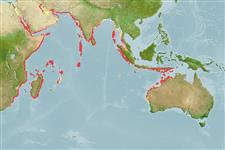Issue
Information on distribution attached to this species may be in error ; data will be corrected as soon as possible following Randall et al., 2014 (Ref. and (Ref. 106074
Environment: milieu / climate zone / depth range / distribution range
Ecology
Marine; demersal; depth range ? - 20 m (Ref. 48636). Tropical
Indian Ocean: from Visakhapatnam and Tuticorin on the east coast of India, and Kovalam in Kerala on the southwest coast.
Size / Weight / Age
Maturity: Lm ? range ? - ? cm
Max length : 16.0 cm TL male/unsexed; (Ref. 6645)
Dorsal spines (total): 6; Dorsal soft rays (total): 9 - 10; Anal spines: 3; Anal soft rays: 34 - 42; Vertebrae: 25. This species is distinguished by the following characters: 49-60 pored lateral-line scales; 4.5-5.5 scale rows above lateral line; 14-18 (usually 16) circumpeduncular scales; absence of blackish spot on pectoral fin base; usually only the tip of dorsal fin blackish; eye huge, diameter 13.0-15.3% SL, 43.6-51.5% HL; very deep body 44.6-49.1% SL; sides of body usually with irregular faint longitudinal light stripes (Ref. 95675).
Usually solitary in caves or under large overhanging corals to about 20 m depth (Ref. 48636).
Life cycle and mating behavior
Maturity | Reproduction | Spawning | Eggs | Fecundity | Larvae
Koeda, K., T. Yoshino, H. Imai and K. Tachinara, 2014. A review of the genus Pempheris (Perciformes, Pempheridae) of the Red Sea, with description of a new species. Zootaxa 3793(3):301-330. (Ref. 95675)
IUCN Red List Status (Ref. 130435: Version 2024-1)
Threat to humans
Harmless
Human uses
Tools
Special reports
Download XML
Internet sources
Estimates based on models
Preferred temperature (Ref.
123201): 25.1 - 29.2, mean 28 °C (based on 1128 cells).
Phylogenetic diversity index (Ref.
82804): PD
50 = 0.5000 [Uniqueness, from 0.5 = low to 2.0 = high].
Bayesian length-weight: a=0.01380 (0.00591 - 0.03225), b=3.02 (2.83 - 3.21), in cm total length, based on LWR estimates for this Genus-body shape (Ref.
93245).
Trophic level (Ref.
69278): 3.4 ±0.5 se; based on size and trophs of closest relatives
Resilience (Ref.
120179): High, minimum population doubling time less than 15 months (Preliminary K or Fecundity.).
Fishing Vulnerability (Ref.
59153): Low vulnerability (10 of 100).
Nutrients (Ref.
124155): Calcium = 254 [154, 450] mg/100g; Iron = 1.38 [0.77, 2.25] mg/100g; Protein = 17.7 [16.7, 18.7] %; Omega3 = 0.176 [0.100, 0.310] g/100g; Selenium = 38.4 [20.5, 75.4] μg/100g; VitaminA = 19.5 [6.6, 58.9] μg/100g; Zinc = 1.48 [1.03, 2.12] mg/100g (wet weight);
